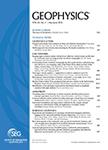版权所有:内蒙古大学图书馆 技术提供:维普资讯• 智图
内蒙古自治区呼和浩特市赛罕区大学西街235号 邮编: 010021

作者机构:Charles Univ Fac Math & Phys Dept Geophys CR-18000 Prague 8 Czech Republic
出 版 物:《GEOPHYSICS》 (地球物理学)
年 卷 期:1999年第64卷第1期
页 面:240-250页
核心收录:
学科分类:07[理学] 0708[理学-地球物理学]
主 题:.NE FD method same time grid steps grid points free-surface
摘 要:Finite-difference (FD) modeling of complicated structures requires simple algorithms. This paper presents a new elastic FD method for spatially irregular grids that is simple and, at the same time, saves considerable memory and computing time. Features like faults, low-velocity layers, cavities, and/or nonplanar surfaces are treated on a fine grid, while the remaining parts of the model are, with equal accuracy, represented on a coarse grid. No interpolation is needed between the fine and coarse parts due to the rectangular grid cells. Relatively abrupt transitions between the small and large grid steps produce no numerical artifacts in the present method. Planar or nonplanar free surfaces, including underground cavities, are treated in a way similar to internal grid points but with consideration of the zero-valued elastic parameters and density outside the free surface (vacuum formalism). A theoretical proof that vacuum formalism fullfills the free-surface conditions is given. Numerical validation is performed through comparison with independent methods, comparing FD with explicitly prescribed boundary conditions and finite elements. Memory and computing time needed in the studied models was only about 10 to 40% of that employing regular square grids of equal accuracy. A practical example of a synthetic seismic section, showing clear signatures of a coal seam and cavity, is presented. The method can be extended to three dimensions.